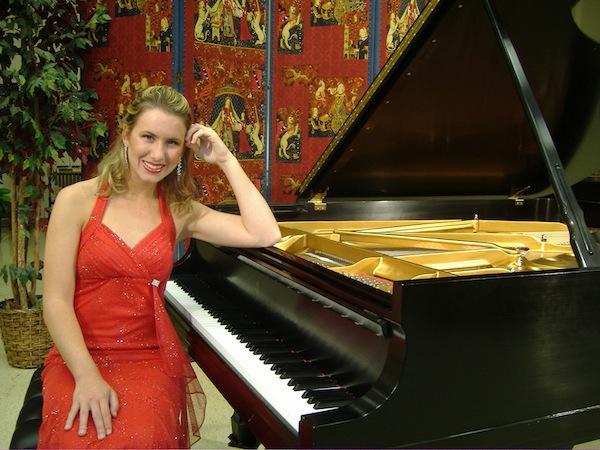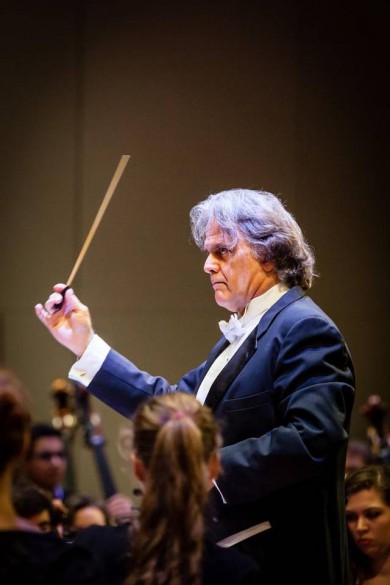An exhilarating young pianist and rich Mahler close season for Frost Symphony

Lindsay Garritson performed Prokofiev’s Piano Concerto No. 2 Saturday night with Thomas Sleeper and the Frost Symphony Orchestra.
Prokofiev’s Piano Concerto No. 2 in G minor is one of the most daunting works in the keyboard-orchestral repertoire. On Saturday night Lindsay Garritson, who has played widely in the United States and Europe and is a doctoral student at the University of Miami’s Frost School of Music, met the concerto on its own terms in a terrific performance with Thomas Sleeper conducting the Frost Symphony Orchestra at the UM Gusman Concert Hall.
The score is the work of the youthful Prokofiev. Wildly impulsive in its hard driving modernism, the concerto is a pianistic minefield.
Garritson counts Frost’s Santiago Rodriguez, himself an outstanding Prokofiev player, among her teachers. She combined pearly tone with the kind of blazing technique that produces musical fireworks. Garritson could turn on a dime from stating the concerto’s opening motif with elegance to blazing through cascading runs and knuckle-busting octaves. She brought strength, accuracy and welcome dynamic variety to the lengthy first movement cadenza.
Garritson’s fleet reading of the Scherzo was matched by Sleeper’s fine pinpointing of Prokofiev’s snarling wind and brass writing. She captured the impish playfulness of the Intermezzo, and her hands darted across the keyboard in a seeming blur in the Allegro tempestoso finale. Yet she also brought fine tonal shadings and rhapsodic sweep to the central Russian folk-inflected episode. Garritson is a pianist of formidable talent and well earned the cheering ovation that followed the performance.
Sleeper was a splendid collaborator, drawing mighty sonorities from the brass (including three trombones) and rich, full-bodied playing from the excellent strings. He fully captured the edgy drive and sarcasm of Prokofiev’s orchestral writing. The coda was exhilarating with both soloist and the orchestra going at full tilt.
The performance of Mahler’s Symphony No. 4 that followed after intermission was in no way anticlimactic after Garritson’s tour de force. Over several decades, Sleeper has consistently drawn strong and committed performances from his players that exceed the student level and this Mahler symphony was no exception.
This score may be Mahler’s most Viennese symphony. As Sleeper pointed out in pre performance comments, some of the themes ring with almost Mozartean simplicity. Still there are darker clouds along the way of the score’s nearly one-hour length, culminating in a soprano solo of child like wonder.
Sleeper took the opening movement at a vigorous tempo. He brought out the zest and lilt of the opening melody while giving heft to the more menacing and martial edges of the development section. The cellos’ splendid unanimity and warmth of tone aptly showcased the Viennese gemütlichkeit of the second theme. Solo turns by oboe and clarinet were beautifully articulated and the trumpet pealed forth in ringing tones at climactic moments.
Playing a second violin tuned a tone higher (per Mahler’s instructions), concertmaster Miclen LaiPang assayed Mahler’s cross between a country dance and macabre totentanz (dance of death) in the second movement with vigor. Sleeper gave incisive spirit to the dance rhythms while emphasizing the sudden harsh wind interjections.
The Poco adagio (third movement) is Mahler at his most lyrical, and Sleeper drew a rich sonority from the lower strings. He never allowed the music to become diffuse, bringing a strong sense of forward momentum while capturing Mahler’s eloquence. The oboe melody that Mahler later utilized in his Kindertotenlieder was given emphatic weight and the triumphant return of melodic material from the first movement was powerfully conveyed in the grand climax.
The symphony’s final movement is a vocal setting of a poem “Das himmlische Leben” (“The Heavenly Life”) from the collection Das Knaben Wunderhorn. It is a child’s view of heaven, requiring a light soprano who can mix the subtleties of fine lieder singing with an aura of fantasy.
With Sleeper expertly coordinating Mahler’s changes of meter and mood, Leslie Zapiain projected the naive innocence and serenity of Mahler’s vocal line. Her high pianissimos were particularly exquisite and she brought a wonderful sense of peace and joy to the final pages. Apart from a few horn misses, Sleeper drew first-rate playing from the ensemble. Miles removed from the angst of Mahler’s later symphonies, the score unfolded with unforced glow and spaciousness. This was first-rate Mahler conducting and a fine conclusion to a season of strong performances by the Frost ensemble.
Posted in Performances
3 Responses to “An exhilarating young pianist and rich Mahler close season for Frost Symphony”
Leave a Comment
Sun Apr 23, 2017
at 12:19 pm
3 Comments

Posted Apr 23, 2017 at 3:49 pm by Simon Finlow
I became convinced of Ms. Garritson’s huge talent after her impeccable, exhilarating performance of Prokofiev’s 7th Sonata at the 2013 Cliburn competition. It’s great to see that she’s becoming more widely recognized as the formidably gifted artist that she is. Congratulations Lindsay! I really hope to hear you perform live again somewhere in my future.
Posted Apr 24, 2017 at 9:37 am by David Cornell
Thanks, Lindsay, I appreciate seeing the expressive review, which made me feel as though I had been present! It’s wonderful to learn about your progress with your study in school and at the piano. Love from Linda and me! Dave Cornell
Posted May 14, 2017 at 1:43 am by Ruth Doering
Dear Marie and Lindsay:
Wonderful review. It would be special if
you were to play here in Arizona.
Scottsdale Center For the Arts
and the Phoenix Symphony are two possibilities.
love to all of you,
Ruth Doering